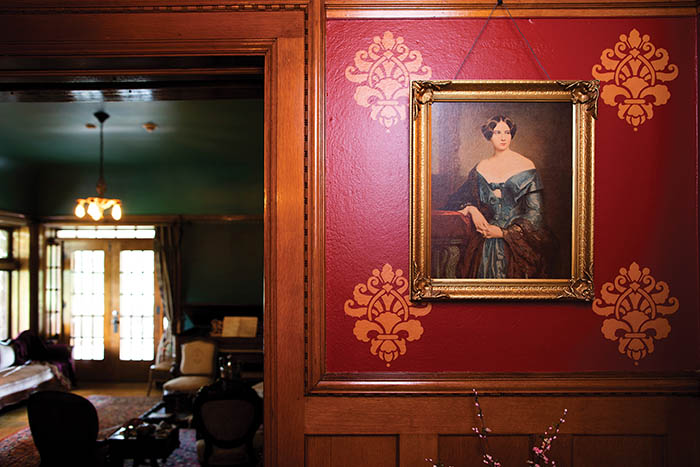If these walls could talk – UNK Frank House


If these walls could talk
The heart of this home beats happily because its walls can now tell the whole story.
The story of all its lives. The story of all its people, who lived here and loved here and (sometimes) died here in this red sandstone mansion on the prairie.
Thanks to a head-to-toe restoration — along with a head-to-toe restoration of its story — this home, now called the G.W. Frank Museum of History and Culture at the University of Nebraska at Kearney, can tell its more complex and compelling story. It’s a story that’s no longer just about the wealthy Frank family who built the house in 1890, but one that also talks about all the people whose hearts once beat within these walls.
The servants, who kept the fires burning and cooked and cleaned and quietly turned in at night to their quarters, up a narrow stairway to the third floor.
The patients, who lived here after the Franks had moved on, when the house became part of the Nebraska State Hospital for Tuberculosis.
The kids with sick lungs. The adults. The fear.
The families who’d visit.
The blood, coughed up into paper bags.
The brave local workers, who took those bags to the incinerator and changed bedpans and rubbed backs and pushed bodies to the morgue, workers who risked their own lives in a time when TB was the nation’s No.1 killer.
The resilience.
Those stories and more are now being told in depth, said William Stoutamire, Ph.D., the director of the G.W. Frank Museum of History and Culture at UNK who oversaw the restoration.
And the museum is now, at its heart, he said, the bigger story of Kearney itself.
“This place tells an important story,” he said. “But the impact of the story is much broader than the home and its grounds. We’re always trying to think, as a museum, how we can reach beyond the walls, to the reverberations, the ripples in the pond, of the impact that the actions and decisions of the people in this house had on the broader community.
“And I think these walls now speak, among other things, of the diversity of the history of this part of the country — a much more vibrant and dynamic history.”
***
Kearney had never seen anything like this house when George and Phoebe Frank built it. Kearney had never seen anything like the gilded Franks, who came from the East with the hope in their hearts to develop Kearney’s industry, complete its canal and turn Kearney into a hydroelectric-powered city, one to rival Minneapolis.
This home was their stage, in a way, a place to throw lavish parties to show potential investors that this part of world was civilized. It was the first home around with indoor plumbing and electricity and radiator heat. One of the Franks’ sons, an architect, designed it. It has hand-carved woodwork and hand-stenciled walls. A grand stained-glass window at the top of the grand staircase depicts a woman, a bird eating from her hand. (Phoebe? No one knows for sure.)
This home became the heart of Kearney’s high society.
But the Frank family’s fortunes wilted. The Panic of 1893 hit them hard, and so did a drought, which dried up the local economy. They went bankrupt. The architect son died young. The oldest, a banker, probably killed himself. After Phoebe died in 1900, George lived his last few years in Lincoln with their daughter.
This home moved on.
By the early 1900s, the Franks were all but forgotten. The Frank House name is a modern anachronism. The home, for most of its life, was simply called the Stone House.
Most of the Franks’ servants were immigrants from Sweden, Germany and Czechoslovakia who barely spoke English, Stoutamire said. They moved on, too, but often they moved into the community.
The next owners of the house were married doctors who turned it into a hospital. After they divorced, the wife kept it going for a few years before selling it to the state of Nebraska, which turned it into the TB hospital for the next six decades.
Most of the patients weren’t from the community. They came from Lincoln or Omaha and beyond. They were the poor who couldn’t afford a sanatorium, people of all colors, living and dying alongside one another in their hospital beds.
Kearney, its economy still recovering from the crash, was happy to have the hospital here in 1912, even if people feared the disease its walls were trying to contain.
As the epidemic grew across the state, the Stone House grew too small. A big brick hospital was eventually built nearby and connected to the Stone House by an underground tunnel (that building is now the home of the UNK College of Business and Technology). The hospital treated up to 300 patients at times. The Stone House became living quarters for the workers and some of the patients’ families.
“Kearney had a mixed relationship with the hospital,” Stoutamire said. “Some people were very happy. Some were afraid of having a hospital here and the potential of an epidemic breaking out in the community.”
The new story here now talks a lot about those local workers, how even though the hospital became a place of fear, it also became a place for opportunity, a way for those workers, often young farm women, to gain financial freedom. Many formed bonds with this place and with one another.
In what could have been such a sad setting, its old photos seem to show happy stories, too.
The new story also talks about how the workers built a sense of normalcy for their patients, especially the children. There were picnics along the Kearney Canal, holiday concerts, big bows in combed hair and smiles that don’t look staged for the camera.
“As far as the people who actually came and spent time out here,” Stoutamire said, “I think it speaks to their humanity — of wanting to do great things for others.”
Eliza Galloway’s story has been restored, too.
She was a servant in the Franks’ household, one of the few African-Americans in Kearney at the time. According to the old story, Galloway was practically a member of the family, a former slave whom the Franks had rescued from homelessness after she had been freed. (Not true.)
Galloway didn’t talk much about herself, so her story has been told through oral histories. To a white woman in Kearney she’d befriend, Galloway told one version — that her slave owners were benevolent, tried to teach her to read and write, but she just hid under the table, too afraid. But on her deathbed, Galloway told a nun a different story — that her life as a slave had been horrific, far worse than anything in “Uncle Tom’s Cabin.”
The new story shows her in context with her times and the limited opportunities she had to advance in life, unlike the Franks.
“With historic house museums,” Stoutamire said, “it’s been so, so, so common, still, today, to basically try to restore the place to the way it would have looked at the time of the first family and erase everything else that happened.
“We’re trying to do something different. We’re trying to show how the history of this place has evolved, how so much has happened since 1890.”
***
If these walls could talk, what would they say about this renovation?
“Hopefully, they’re happy,” Stoutamire said. “Hopefully, they like what we’ve done.”
He credits all of the generous people who’ve donated to the museum for making this renovation and rebranding possible. The vast majority of this work, he said, has been done with that support.
“We have received some external grants,” he said, “but by and large, it’s been done through the support of people through the University of Nebraska Foundation.”
If these walls could talk, what would they say to those donors?
“I think the walls would say, ‘Thank you,’ and that this place probably wouldn’t be here without them,” Stoutamire said. “And I think these walls would say, ‘Come see what good can be done with your donations.’”





